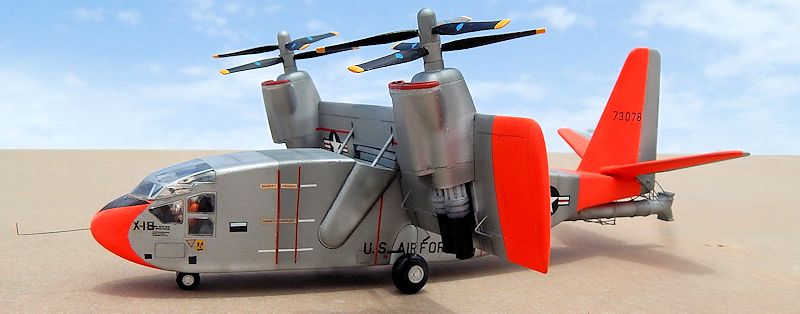
Aurora 1/70 Hiller X-18 Convertiplane
| KIT #: | 146-98 |
| PRICE: | 7/6 |
| DECALS: | One option |
| REVIEWER: | Carmel J. Attard |
| NOTES: |

| HISTORY |
Design work started in 1955 by Stanley Hiller Jr and Hiller Aircraft Corporation
received a manufacturing contract and funding from the U.S.A.F to build the only
X-18 ever produced, serialled 57-3078.
To speed up construction and conserve money the plane was constructed from
scavenged parts including a Chase YC-122 Avitruck fuselage,
49-2883, and
the turboprops came from the Lockheed XFV-1 and
 Convair XFY-1 Pogo experimental
fighter programs. The tri-bladed contra – rotating propellers were a giant 16 ft
(4.8 m) across. The Westinghouse turbojet engine had its exhaust diverted
upwards and downwards at the tail to give the plane pitch control at low speeds.
Hiller nicknamed their X-18 the
Propelloplane for public relation purposes.
Convair XFY-1 Pogo experimental
fighter programs. The tri-bladed contra – rotating propellers were a giant 16 ft
(4.8 m) across. The Westinghouse turbojet engine had its exhaust diverted
upwards and downwards at the tail to give the plane pitch control at low speeds.
Hiller nicknamed their X-18 the
Propelloplane for public relation purposes.
The first test flight was on November 24, 1959, ultimately recording 20 flights
out of Edwards AFB. A number of problems plagued the X-18 including being
susceptible to wind gusts when the wing rotated, acting like a sail. In addition
the turboprop engines were not cross-linked, so the failure of one engine meant
the airplane would crash. Thrust control was through throttle changes, which
were too slow for acceptable height and roll control.
On the 20th and final flight in July 1961, the X-18 had a propeller pitch
control problem when attempting to convert to a hover at 10,000 ft and went into
a spin. The crew regained control and landed, but the X-18 never flew again.
However ground testing of the tilt wing concepts continued. Eventually a VTOL
Test Stand was built on which the X-18's vertical takeoff and landing and hover
control was to be tested. One engine run was successfully conducted to the full
15-foot wheel height on the VTOL Test Stand. The program was cancelled on
January 18, 1964 before further VTOL Test Stand testing could be conducted, and
the X-18 was cut up for scrap.
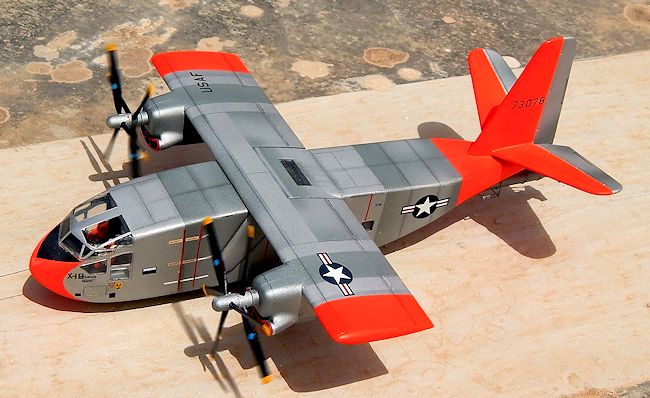 The program proved several things that contributed to further tilt-wing VSTOL
technology programs:
The program proved several things that contributed to further tilt-wing VSTOL
technology programs:
1.
Cross-shafting between the engines was mandatory in order to avoid loss of
control in the event of an engine failure.
2.
Direct propeller pitch control was mandatory for precise height and lateral
control during VTOL and hover.
This knowledge was employed in the successful development and flight tests of
the Tri-Service XC-142A, tilt-wing VSTOL transport. The X-18 has a length of
63ft, a wing span of 47ft.11inches and a height of 24 ft.7inches. It was powered
by two Allison T4C-A-14 coupled turboprop engines 5,500 hp each and one
Westinghouse J34 Turbojets 3,400 lbf thrust
The turboprops drove 6 bladed Aeroproducts 14 ft Diameter contra rotating
propellers The convertiplane had a maximum speed of 253mph and a service ceiling
of 35,300 feet.
| THE KIT |
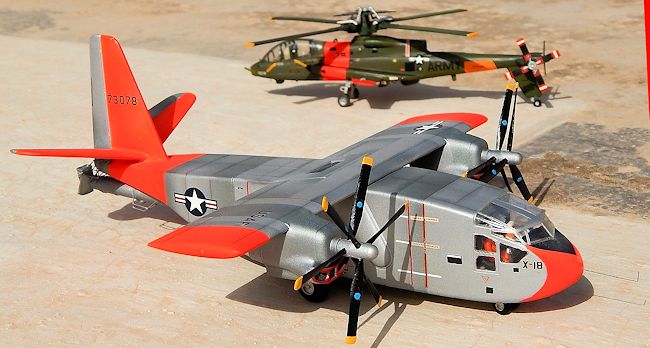 The kit released by Aurora in 1963 which is an ex-Comet model kit, same mold;
same
parts.
The kit released by Aurora in 1963 which is an ex-Comet model kit, same mold;
same
parts.
The kit features recessed panel detail, and has several working parts which was an important feature in those early days of Aurora kits. These included two sets of contra rotating propellers, tilting wings at different angles, rotating wheels and a nose wheel that swivels. The instructions has five stages of sub-assembly: the engines, undercarriage, fuselage, wings and final erection of all the sub assemblies. The kit has 45 parts and 9 clear parts.
| CONSTRUCTION |
Having down loaded scale plans of the X-18 this indicated that the main
diference between the kit and drawing was the additional trunking that connects
to the ducts at the rear of the aircraft. The first step was to separate the two
way aft duct box cut away from the rear fuselage. The area was then made flush
with a little filler and sanded to shape.
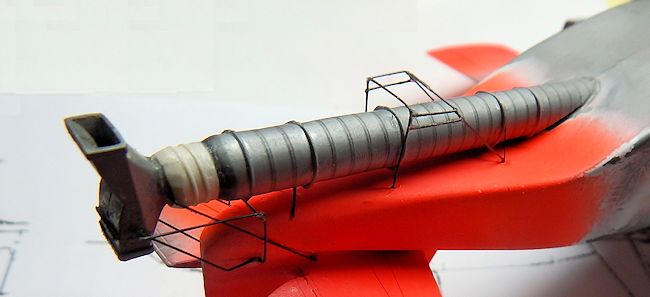 The kit was then assembled following the instructions. As I had the intension to
preserve even the working parts of the kit as released I also assembled the
engines and props without the normal procedure of painting these and which were
normally left till the end when they are put on the kit. The tilting feature of
the wings was also operative ensuring that the wing elevator rods were free to
retract. A stand socket at the base of the kit was blanked and sanded smooth.
The kit was then assembled following the instructions. As I had the intension to
preserve even the working parts of the kit as released I also assembled the
engines and props without the normal procedure of painting these and which were
normally left till the end when they are put on the kit. The tilting feature of
the wings was also operative ensuring that the wing elevator rods were free to
retract. A stand socket at the base of the kit was blanked and sanded smooth.
The long trunking fitted at the base of rear fuselage was made from a B-29
internal travel shaft which was surplus from previous kit assembly. This had a
similar diameter to the trunking that was connected to the jet engine which
helped to provide part of the lift and overall stability of the X-18 when in
flight. This was measured and cut to the correct length one end of which had the
duct box and the other end cut at a
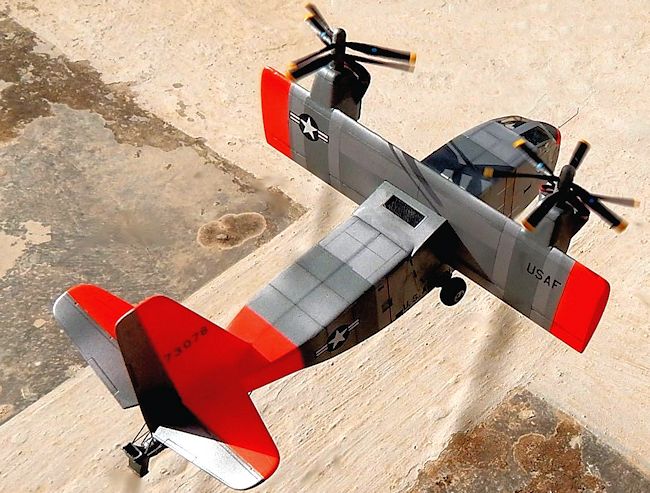 chisel shape to conform to the rear slanting
fuselage. Many of the rings on the outside of the B-29 tunnel were removed by
careful filing and only four of these were retained. The trunking was secured
with a set of brackets that I made from metal wire. Finally a nose probe was
added to the fuselage.
chisel shape to conform to the rear slanting
fuselage. Many of the rings on the outside of the B-29 tunnel were removed by
careful filing and only four of these were retained. The trunking was secured
with a set of brackets that I made from metal wire. Finally a nose probe was
added to the fuselage.
Other detail that was added to the kit during assembly was addition of elevator
control links which were made from metal wire; a complete cockpit office with
two crew seats, cockpit floor and bulkhead. Two fire extinguishers added to the
wall, central console and cockpit coaming. Lead weight was secured to the
forward nose area. Rectangular heat resisting plates were made from thin plastic
card and fitted right between the engine exhausts and lower wing panels.
| COLORS & MARKINGS |
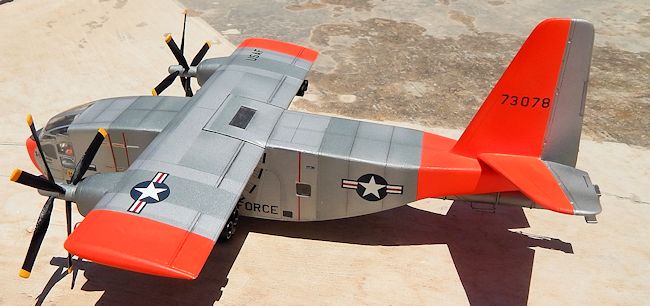
| CONCLUSIONS |
In spite of the age on the kit it was found to be accurate in every respect and
the project itself regenerated important past history in the early research and
development of the convertiplane concept, an evaluation programme that would
otherwise remain unnoticed but which was already underway long before the
emergence of the V-22 Osprey development concept.
| REFERENCES |
July 2014
If you would like your product reviewed fairly and fairly quickly, please
contact
the editor
or see other details in the
Note to
Contributors.